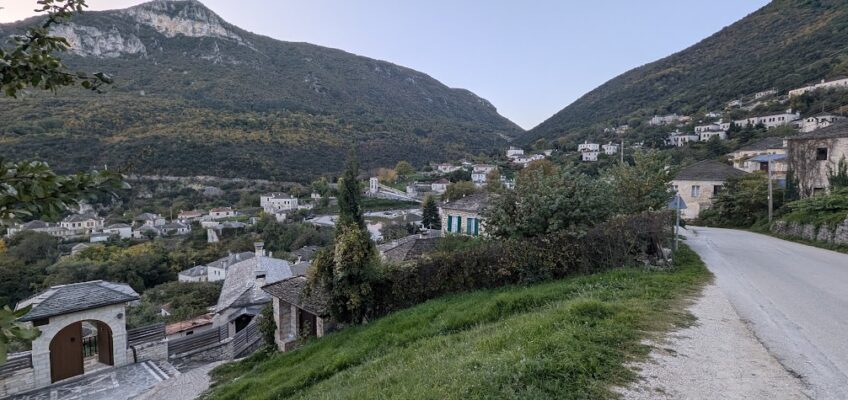I expected my travels to Greece to consist primarily of seeing ancient ruins and experiencing Greek culture. I didn’t expect so much scenic beauty. And then we came to Ζαγόρι (Zagori) and I was blown away for the third time in the past four days, but this time because the landscape is stunning.
Some of what’s so stunning is the delightfully charming villages, and some is the gorgeous vistas, whether looking up at the hills from below or down at the valleys from above. Either way, Zagori is one of the most beautiful places I’ve visited in all my travels.
It didn’t hurt that there were almost no tourists (besides our group). While October is peak season in some parts of Greece we already visited, Zagori is a summer destination for Greek travelers, and seemingly not well known (yet). I suspect word will get out now that (as of 2023) Zagori is a UNESCO World Heritage Site.
Μέτσοβο
But before we got to Zagori, we stopped in Μέτσοβο (Metsovo). And that was also a pretty town in a gorgeous setting. There we had some time to walk around and had a cooking lesson (we made pies with spiced beef and feta cheese) and lunch.
Surprisingly for such a small town, there is a fine little art museum, the Averoff Museum. It features Greek artists from the 19th, 20th, and 21st centuries.
From Destruction to Rebirth (1968)
Here are all my photos from Metsovo.
Zagori
This is what UNESCO says about Zagori:
An impressive network of stone-arched bridges, stone cobbled paths, and stone staircases linking the villages in the present Municipality of Zagori formed a system that served as a political and social unit connecting the communities [of the Vikos and] Voïdomatis River basin. Zagorochoria are typically organized around a central square containing a plane tree [a sycamore planted by early settlers hundreds of years ago to see if there was enough water]. Each village showcases drystone cobbled pathways adapted to the topography, and some are still surrounded by sacred forests maintained by local communities. The central square is dedicated to community life, and functions as a centre for social gatherings and religious events. Combining natural and cultural elements, Zagorochoria exhibit a traditional architecture of limestone masonry that persists but has become vulnerable due to socio-cultural and environmental pressures.
There are 46 villages in Zagori, all connected by these paths and bridges. A photo of the one we stayed in, Aristi, is at the top of this post.
Our Vikos Gorge Hike
We hiked from the village of Vitsa down into the Vikos River gorge, crossing two of the bridges.
Voïdomatis River Rafting
After our hike we had lunch and then did a rafting trip for about an hour on the Voïdomatis River.
If you’re not yet convinced that Zagori is one of the most beautiful places on earth, check out the rest of my photos.
Ιωάννινα
We left Zagori this morning and traveled to Ioannina. This was our last stop in Greece before heading to Albania, where I am now as I write this. Ioannina dates from the Byzantine era, but its early history is unknown, other than that it was founded sometime in or prior to the 9th century. The original walled city was upgraded during the Ottoman period. So there are both Christian and Muslim aspects. It’s also a center of the jewelry industry. We visited a jewelry maker and got a demonstration of how he makes jewelry from silver. And we had lunch there.
I took a few photos. Here they are.


Susan G Hale
OMG! Lane I just perused all your blogs from this trip. Amazing ! I really enjoyed living through your photos and commentary. Also relived my trips to Rome through your blog. Thank you !
Joy Sherman
Dear Lane,
I’m immensely enjoying your blogs and pics as you travel the world. Thanks so much for taking the time to share with all of us!
Lots of love, Joy